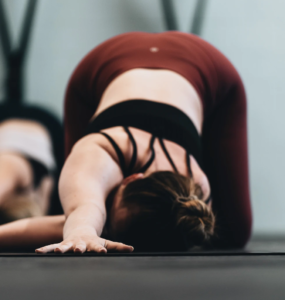By Iris Farrou
01 Sep, 2023
Lifestyle Tips, Menopause, New Moms, Peri-Menopause, Peri-Menopause, Postpartum, Prevention, Women's Health
abdominal, Childbirth, constipation, dysfunction, floor, obesity, Pain, painful sex, pelvic, Physical Therapy, pilates, Pregnancy, pregnant, PT, tailbone, weakened pelvic floor, Why is sex painful

When we hear about pelvic floor exercises, we often associate them with either older women, or pregnant women/women who have just given birth. This is a common misconception–older women and new mothers may see immediate benefits when engaging in pelvic floor PT, but everyone can benefit from it.
No matter your age or overall physical health, if you were assigned female at birth, knowledge is power when it comes to knowing what your pelvic floor looks like, and what it does:
- Imagine your pelvic floor as a hammock of support consisting of muscles, tendons, ligaments, nerves, and connective tissue. This hammock is between the tailbone and the pubic bone.
- First and foremost, your pelvic floor supports the bowels, bladder, uterus, and vagina; there are also muscular bands that pass through the pelvic floor that encircle the urethra, vagina and anus.
- All this, when it functions properly, plays a key role in bowel and bladder control. Your pelvic floor also helps you stabilize your pelvis and your spine, and assists with sexual function.
Who is at risk of Pelvic Floor Dysfunction?
Remember that the pelvic floor is mostly made up of muscles, and like any muscles in our body those–too–can weaken or suffer damage and lead to pelvic floor dysfunction. People who have experienced pregnancy, childbirth, chronic constipation, or obesity may be at higher risk as their pelvic floor has, and does, work harder to support their normal bodily functions and the bowels/bladder.
Some of the symptoms of pelvic floor dysfunction may include pain during intercourse, bladder pain, bowel or urinary incontinence, frequent urination, persisting pubic, tailbone, or lower abdominal pain, and constipation–to name a few. More serious issues may include pelvic organ prolapse: bowel prolapse, prolapsed uterus, and even endometriosis.
How can Physical Therapy Help?
Physical therapists are not just experts who help you walk better after an injury, they are medical experts in the functions of muscles, joints, and nerves, and have an in-depth and holistic understanding of human health. Just like any medical field, PTs have areas of expertise and you may want to work with someone who is trained on pelvic floor functions.
A PT will assess your whole body after consulting with you, not just the problem or painful areas. Your medical history, symptoms, and needs will of course be taken into account to create an individualized plan for your pelvic floor health. The exercises will, and should, be done with the physical therapist–unless they assign you specific exercises to do at home. Since our pelvic floor is basically holding everything in our body together, the center so to speak, don’t be surprised if some exercises are not directly working on the pelvic area; ask your PT to explain why they are assigning you an exercise, and how it will help you. Some soreness or aches are normal after your PT sessions, but this is not a “no pain, no gain” situation: at no point during PT should you feel acute pain or strain on your muscles/ligaments.
And for this subject, the saying “the sooner, the better” cannot be emphasized enough: do not wait until you’re older, pregnant, or have any painful symptoms to get started on strengthening your pelvic floor.
More
By Iris Farrou
22 Apr, 2023
Diet & Exercise, Lifestyle Tips, Menopause, Peri-Menopause, Peri-Menopause, Pregnancy, Prevention, Queer Health, Reproductive health, Sexual health, Women's Health
bladder control, Body Changes In Menopause, bowel function, Childbirth, core strengthening, Early menopause, ease the birthing process, estrogen loss, Frequent urination, Kegel, natural delivery, Pelvic Floor, pelvic floor dysfunction, pilates, Strengthen pelvic floor muscles, stress urinary incontinence, SUI, UTI, vaginal delivery, weak bladder

Maybe the first word that comes to mind when you hear about Pelvic Floor Exercises is “Kegel”! Yes, that’s correct– Kegel exercises are one way to exercise your pelvic floor muscles, but they are not the only ones. Kegel balls have lately become popular as an easier and faster way to strengthen your pelvic floor muscles, increase sexual pleasure, and prevent incontinence (especially if you were Assigned Female at Birth–AFAB). However, there is much debate over them, so before we worry about that we will provide some information on the benefits of pelvic floor exercises in general.
What are the benefits for AFAB people?
- Pelvic floor exercises improve bladder and bowel function control, which can be extremely helpful after childbirth or in older years. It can help with constipation, and with incontinence.
- Strong muscles on your pelvic floor can also significantly reduce the risk of prolapse.
- If you are considering childbirth, they do support vaginal delivery, and strong pelvic muscles will also greatly improve your recovery from childbirth and other gynecological surgeries.
- They are reported to help with vaginal contractions and blood flow during sex, thus increasing sexual satisfaction and orgasmic potential.
Like any self-care routine, and especially an exercise routine that helps you strengthen your muscles, training your pelvic floor muscles can help you increase your social confidence and overall quality of life.
How do they help with pregnancy and delivery?
Your pelvic floor muscles are first in line to be affected if you become pregnant; the weight of your growing baby will undeniably put extra strain on the pelvic floor. In addition to the weight, hormonal changes in pregnancy cause your muscles to soften and stretch more easily. That can lead to bladder/ bowel problems while you are pregnant and after giving birth.
It is recommended to start strengthening your pelvic floor as soon as you learn that you are pregnant. Strong muscles in the area will reduce the risk of bowel or bladder problems during your pregnancy, you will learn how to control your muscles to assist with contractions during childbirth (in the case of vaginal delivery), and with a strong pelvic floor you will return to normal much easier after delivery.
What happens to the pelvic floor after menopause?
After menopause, the production of estrogen in our bodies significantly reduces. This can lead to weaker or stiffer muscles on the pelvic floor. Connective tissues may provide less support, and along with a lifetime of bad habits and lack of specific exercise, we may be in danger of experiencing pelvic floor dysfunction.
The pelvic floor muscles are part of your spine and pelvis. If they are struggling, you may experience pain in your lower back. Weak pelvic muscles can also lead to Stress Urinary Incontinence (SUI), which means you may not be able to control your bladder during seemingly simple activities, like laughing, coughing, or sneezing. More serious pelvic dysfunctions can be pelvic organ prolapse–which can be avoided with pelvic floor rehabilitation–and bowel and urinary urgency, where we may not be able to control the urge to urinate or defecate and incidents of leakage may occur.
No matter your age, it is never too soon or too late to start looking into pelvic floor exercises or rehabilitation that are best for you, your physical condition, and your abilities.
https://www.pelvicfloorfirst.org.au/pages/pelvic-floor-muscle-exercises-for-women.html
https://www.pregnancybirthbaby.org.au/pelvic-floor-exercises
https://provenancerehab.com/aging-and-the-pelvic-floor/
More


